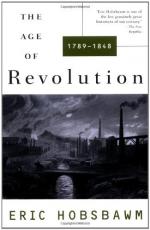
|
| Name: _________________________ | Period: ___________________ |
This test consists of 15 multiple choice questions and 5 short answer questions.
Multiple Choice Questions
1. How did the concept of nationalism spread through Europe?
(a) From west to east.
(b) From France outward in every direction.
(c) From north to south.
(d) From east to west.
2. What does Hobsbawm say revolts turned against in this period?
(a) Aristocratic rule.
(b) Mercantile colonialism.
(c) Alien rule.
(d) Absentee landlords.
3. What does Hobsbawm say was the greatest influence on political thought in the 19th century?
(a) The Renaissance.
(b) The French Revolution.
(c) The Industrial Revolution.
(d) The ancient Greeks.
4. What happened that fostered nationalist movements in the Balkans?
(a) The Russians opened trade with the Balkan areas.
(b) The Turks invaded, uniting the Balkan states against them.
(c) The Greeks attained independence and fixed borders.
(d) Greeks began to flee to the Balkans to get away from the fighting in Greece.
5. What were the dates of the Napoleonic Wars?
(a) 1792-1815.
(b) 1789-1815.
(c) 1791-1812.
(d) 1812-1815.
6. What was Robespierre's role in the Reign of Terror?
(a) He incited the people to carry it out.
(b) He conceived the idea for it.
(c) He was persecuted by it.
(d) He oversaw it.
7. What did Hobsbawm say was the new law of businesses in the late 1700s?
(a) Buy locally, sell globally.
(b) Get big or die.
(c) Buy low, sell high.
(d) Create a niche.
8. What relationship had begun to dominate between landowners and farmers in England in the late 1700s?
(a) Frontiersmen were opening new lands in Europe.
(b) Landlord and tenant-farmer.
(c) Lord and vassal.
(d) Communal ownership.
9. Why did the international congress among Europe's ruling nations dissolve after a few years?
(a) Its members launched an unsuccessful war together.
(b) The interests of its main powers diverged.
(c) Its members conspired against each other.
(d) It was replaced by another alliance.
10. Where did Britain expand its relationships after the French Revolution?
(a) With France and Spain.
(b) With China and Indonesia.
(c) With its colonies.
(d) With Russia and Prussia.
11. What was the Code of Napoleon?
(a) The reform that abolished feudalism.
(b) The currency policy that financed the Napoleonic wars.
(c) The criminal law instituted by Napoleon.
(d) The bureaucratic system instituted in France.
12. What area was affected by what Hobsbawm calls the third wave of revolutions?
(a) All of Europe.
(b) Eastern Europe.
(c) Western Europe.
(d) The Mediterranean.
13. What did the French Revolution create in Spain?
(a) Freedom movements in the Catalan region.
(b) Resistance to democracy.
(c) Resistance to monarchy.
(d) New forms of government.
14. When does Hobsbawm say the second wave of revolutions took place?
(a) 1840.
(b) 1830s.
(c) 1825.
(d) 1815.
15. Why does Hobsbawm say that the Industrial Revolution could only have happened in England?
(a) Because the Industrial Revolution required a cooler climate.
(b) Because agriculture thrived in England's moister climate.
(c) Becaue only Britain had the commercial strength and social conditions for it.
(d) Because the rest of the continent was consumed in war.
Short Answer Questions
1. Who dominated the Third Estate in the 1780s in France?
2. Why did the French state have a financial crisis in the 1780s?
3. Where were the French forces superior to the English?
4. What was the age of scientific and political progress in the 1700s called?
5. What trend was Hobsbawm looking for in revolts and revolutions?
|
This section contains 557 words (approx. 2 pages at 300 words per page) |

|




